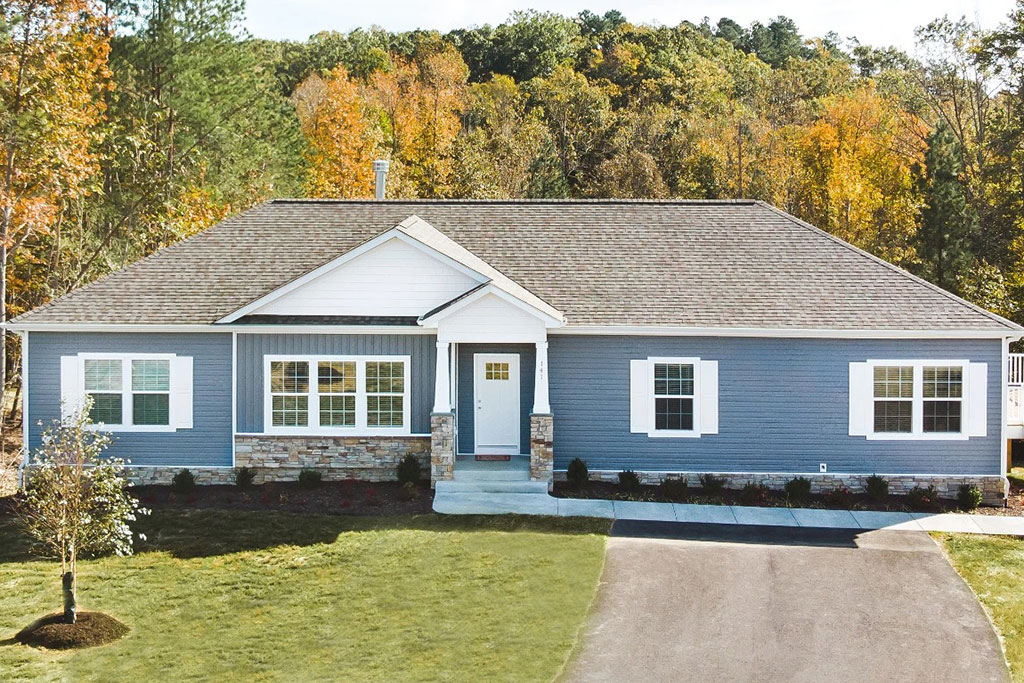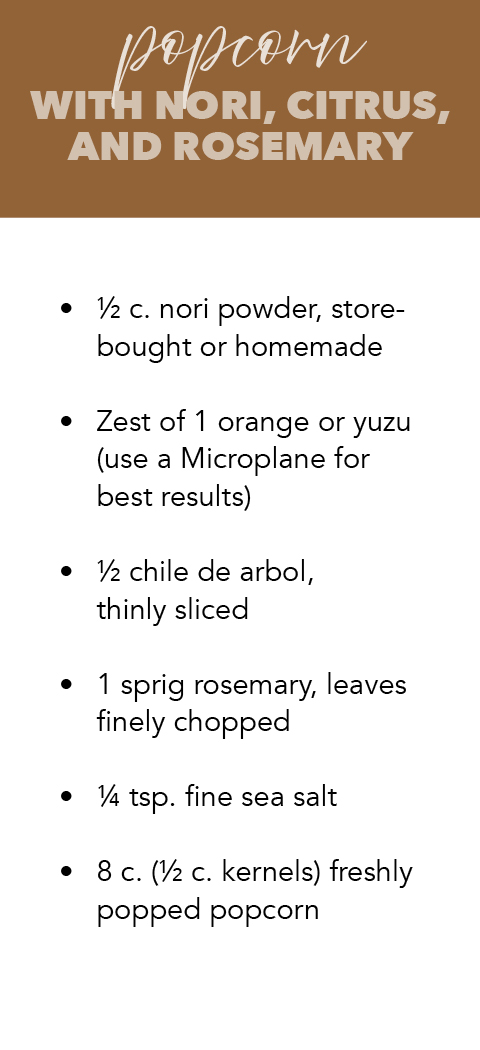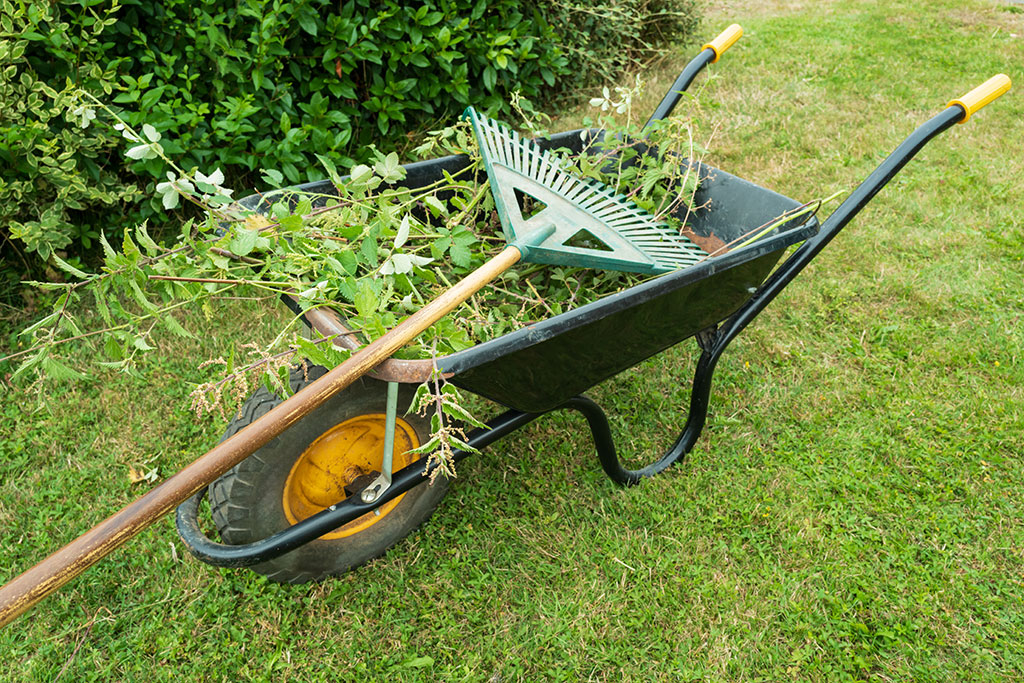



 +
+


 +
+


 +
+


As the last traces of winter fade away and spring begins to bloom, you’ll find many new opportunities to revitalize your home and your life. To help you do just that, this issue of Good to Be Home provides an inside look at the role of an interior designer, a guide to the pluses and minuses of buying a prefabricated home, delightful recipes bursting with flavor, and tips for clearing out winter debris and refreshing your yard.
An interior designer can wear many hats, including that of muse, stylist, and manager. But exactly how do they help their clients create beautiful and functional spaces? In this issue, Shelagh Conway of Triple Heart Designs shares how hiring such a professional can help you navigate the complexities of a home renovation and turn your vision into reality.
Among the more traditional housing offerings, you may have noticed one option becoming increasingly popular: prefabricated homes. Inside, you’ll find an exploration of the two top types—manufactured and modular houses—as well as their upsides and drawbacks, how they’re built, and guidance for purchasing and financing one.
Change is in the air, making now an ideal time to switch up your recipes for something totally different. You can get started with the two in this issue: a roasted eggplant dish dressed with tahini, sumac, and crispy chickpeas followed by a popcorn snack seasoned with citrus zest, rosemary, and nori. Both options may leave you reaching for more.
You may want to roll up your sleeves this month to get your lawn and outdoor furniture ready for hosting fun spring activities and get-togethers. Use the enclosed guide to determine what steps you need to take to get it in tip-top shape, from cleaning up debris to prepping the soil to planting fresh flowers for a beautiful landscape.
Here’s to an amazing March! As always, it’s a pleasure to send you this magazine.
 +
+


An interior designer’s work may seem to be purely creative—an eye for what looks just right. But there is far more than aesthetic talent involved in helping people achieve a finished home. Shelagh Conway of Triple Heart Design in Austin, Texas, reveals what exactly professionals like her do to make their clients’ visions a reality.

Tell us about your design background:
I have been doing interior design for a better part of my life, but it took a while to realize I had a knack for it, and I certainly never thought about doing it as a career. Before, I actually worked a corporate job and would simply renovate houses on my own. Then I ended up renovating houses for my boss; I was working a full-time job while traveling and managing remodeling projects remotely. After about the fifth home, I found that I not only enjoyed it but was also good at it. So I quit my corporate career and opened Triple Heart Design in 2016.
What are some struggles homeowners may experience with a design or renovation project?
While most homeowners can handle choosing materials, they may lack the knowledge to manage the details that make a well-thought-out project shine, especially when construction is involved. They don’t always understand how the installation process works, what building codes are, or how to deliver the necessary drawings and/or information to contractors, builders, and other such professionals. Even more, they typically struggle to answer the follow-up questions these tradespeople may ask and end up having design decisions made for them, resulting in frustration.

How can an interior designer help with the process?
There are multiple benefits they can provide. For one, while designing is a highly creative field, it is also an incredibly analytical one. When clients come to me, they often want the beauty of a renovation but don’t have a clear understanding of the functional aspects of planning one. I’m trained to focus on the details, looking at the form, function, and flow of a home before even getting into selecting aesthetic elements. I consider each room’s floor plan and purpose, whether it’s for entertaining guests, hosting family members, or raising kids, so I can make smart suggestions or decisions that best suit the client.
Further, working with a designer means having someone who knows how to project-manage and communicate with any other professionals involved as well as confer knowledge to you in a way you can understand. Take a project requiring home construction. Architects and builders have the best intentions, but sometimes things get missed or misconstrued, leading to a finished result the client doesn’t fully enjoy. A designer will do functional reviews of the floor plan and work closely with the contractors and/or architects to ensure the smoothest route to the client’s desired outcome, crafting detailed drawings that help them build with strong design intent. This helps minimize miscommunication and any major adjustments that can otherwise occur.
How do you work with a client to determine their needs and wishes?
On our first consultation call, I ask the client questions about their lifestyle and look at photos or videos of their home to get a sense of their style and tastes. Some are unsure of what they want, so we spend a good amount of time looking at Pinterest on a shared board to dial in on what they like. Since I know what a home needs to be cohesive, I guide them through these steps, helping them make choices that feel perfect for them and align well with the home’s architecture.

What is the process of procuring goods for a home?
This is where I think many clients have a skewed notion of what designers do. I like to call it the Bewitched vision: they think we just wiggle our noses and put stuff together when, in reality, we spend hours making sure that the items we source will work in the overall design. Our process begins the same way for every client. We analyze the home’s floor plan, windows, doors, cabinet depths and heights, electrical diagrams, and more to gain an understanding of the current configuration and where our opportunities and constraints lie. Then we move onto concept design, discussing both preferences and budget.
At that point, for our full-service interior design clients, we transition to the materials and selections phase. We review each item or material’s technical specs, installation methods, etc. and communicate these details to the various contractors, if necessary. This is the longest and most detailed aspect of the job—there isn’t ever an item sourced that doesn’t go through a rigorous decision-making process. Finally, once construction begins, we go about selecting furnishings, window treatments, and decor as requested.
How long does it take to go from initial contact to end results?
On average, we spend six to ten weeks in design development for smaller projects and three months to a year for larger ones. This ultimately depends on the permitting, contractors, and client as well as the time they need to make decisions as we move through the process.
What would you say to someone who may have budget concerns?
Working with an experienced designer as your guide and advocate can actually save you money in the long run. I know that seems counterintuitive, given the cost, but they will diligently strive to foresee expensive problems in advance and collaborate with contractors and suppliers to execute designs within your price limits.

How do you suggest that clients find the right designer for their needs?
As with any trade or professional service, everyone has a unique style, approach, and process. Personally, I aim to design spaces that have a zen-like quality to them and promote healthy living, so I gravitate more toward natural materials. I believe that they emit a palpable energy, and I take extra care when picking them to ensure that they match each project I’m working on. If you’re looking for design assistance, make sure to do your research, interview several people, and request detailed information about each one’s areas of expertise so you can find the one who resonates most with you.
For more info, visit tripleheartdesign.com
 +
+


Are you dreaming of a modern, eco-friendly home without the hefty price tag? A prefabricated house, or one manufactured in a factory, may be the way to go. While just starting to catch on in the United States, this option is already popular in countries like Japan and Sweden for its sustainable features and ability to go up in weeks, saving consumers both time and money. Learn more about these intriguing benefits along with two different types of prefab structures worth considering—manufactured and modular homes.

As housing affordability continues to be an issue across the country, finding a “stick-built,” or traditionally constructed, home that fits your budget can prove to be challenging. Prefabricated ones, such as those from leading manufacturers Clayton and Champion Homes, offer a solution that can be as much as 25 percent cheaper, generally costing less per square foot. Of course, there are other expenses you’ll have to factor in as well, including for the lot or land you’ll put it on and to attach your utilities or build a foundation, if needed. But if you manage your budget well, this could prove to be an ideal cost-effective option, whether you’re a first-time buyer or looking for your retirement retreat.
In addition to their relatively low sticker prices, prefab homes can be quite sustainable in many ways. For one, they are engineered to have a great deal of structural integrity thanks to three primary factors: they must adhere to both national and local building codes, they’re made from the same high-quality materials as stick-built homes, and they’re built in controlled factory conditions, meaning they aren’t exposed to wind, rain, and other elements during construction. As a result, they can be resilient to hazardous conditions like flooding and strong winds, sometimes even withstanding hurricane-force winds.
Prefab houses also produce lower waste during the construction process and typically offer many green features. These may include roofs with sheathing technology, advanced insulation techniques, and double- or tripled-paned windows insulated with argon gas to help regulate indoor temperatures and minimize energy loss. In turn, you can potentially reduce both your carbon footprint and utility bills by an incredible amount.

Previously called mobile homes, today’s manufactured houses are a far cry from their less structurally sound predecessors. Built in a factory and then transported fully complete to a site, they are held to strict standards regulated by the Department of Housing and Urban Development (HUD), helping to guarantee their quality. While these homes are “mobile” in the sense that they’re able to move sites if desired, many owners these days choose to remove this element by attaching theirs to a permanent foundation, providing more stability and better curb appeal.
Although typically only one story, manufactured homes are available in a variety of architectural styles and sizes and can be outfitted with all the latest bells and whistles, such as on-trend flooring and eco-friendly lighting, making them almost indistinguishable from traditional houses. According to Federal Reserve Economic Data, the average sales price of a new, single-family manufactured home in May 2024 was $86,500, which was much lower than that month’s average price for a new, single-family stick-built house at $520,000 per HUD. (Note, though, that the latter price includes the land.)
However, there are potential wrinkles to keep in mind when purchasing a manufactured home. To start, they aren’t permitted in all municipalities, so you may be restricted as to where you can place yours. A manufactured-home community—of which there are 43,000 in the United States—may be your best bet. You may even be able to purchase a home resale there for a lower price.
Moreover, manufactured homes don’t always qualify for a traditional mortgage. Generally, to be eligible, they must be titled as real property, the process for which can vary per state; in some cases, you may be required to affix your house to the land with a foundation and own the underlying property as well. Alternatively, there are certain FHA or VA loans you may qualify for, or you could use a chattel loan, a type of financing for personal property that’s similar to an auto loan. Just keep in mind that this option tends to have higher interest rates and shorter repayment terms.

Only partially constructed in a factory, modular homes are composed of sections, or modules, that are premade in controlled conditions and then secured together by a builder on-site. Unlike manufactured homes, these houses must always be placed on a permanent foundation for stability. They’re also held to the same standards of traditional homes, meaning they must adhere to the International Residential Code and comply with local, state, and regional building codes.
While still more affordable than conventional houses, modular homes are generally more expensive than manufactured ones; according to Rocket Mortgage, they had an average price of $270,000 in September 2024. But with this extra cost often comes more flexibility, allowing you to combine modules to create your ideal floor plan within the manufacturer’s limitations. For example, you could add one to the main floor for additional living space or, in the case of a smaller lot, use them to create a second story instead. Even more, you can choose from a wide range of styles, including contemporary, Cape Cod, and Colonial.
When purchasing a modular home, you’ll likely have the same financing options as for a stick-built home, including conventional mortgages, FHA loans, and VA loans. However, you might need a construction loan first to pay for costs like labor and buying your property; some such loans can be converted to a traditional mortgage later. Certain lenders may also offer specialized modular-home mortgages, and your manufacturer might provide financing options.
Prefabricated houses can present a promising path to a more sustainable and affordable future. With the potential to reduce your cost of living as well as your environmental impact, they’re a compelling option for homebuyers seeking both practicality and beauty.
 +
+


Planning a dinner at home? Elevate your evening with these two recipes from The Modern Larder cookbook. Start with a delectable roasted eggplant dish as the star of your meal, then delight in a creative twist on popcorn to finish the night. Together, they promise a memorable experience that will linger long after the last bite.
Perfect as a main course or stunning side, this dish features an array of ingredients that provide the perfect mixture of textures and flavors.
After a taste of this delightful popcorn topped with a subtly tart and herbaceous seasoning, you’ll crave it every time.
Recipes from The Modern Larder by Michelle McKenzie. Roost Books, an imprint of Shambhala Publications, Inc., 2021. Recipe photographs © Rick Poon.
 +
+


recipe by michelle mckenzie
photos by rick poon
Eggplant is one of my favorite vegetables—I could fill an entire book with recipes singing its praises, and I don’t see why it can’t be the star of the show rather than just a supporting act. In this large-format dish, whole eggplants cook until slightly charred on the outside and meltingly tender within. Tahini adds much-needed richness and creaminess, crispy chickpeas add texture (and protein), and lemon and sumac bring brightness. I consider this a lovely vegetarian main course, but it could also serve as a side dish for chicken, lamb, or fish. Any leftovers can be blitzed into a fine eggplant dip in the food processor (add an ice cube for the smoothest result) and refrigerated for up to 3 days.

4 servings





 +
+


recipe by michelle mckenzie
photos by rick poon
Popcorn is a snack that somehow seems light and indulgent at the same time. It is welcome at any time and for every occasion. Buttered and salted, popcorn is very good. But it is made remarkable when showered with a striking mix of nori, citrus zest, and fresh rosemary. Make more of this seasoning than you need and sprinkle it on fried eggs, cold soba noodles, green salads, grilled vegetables, or fish.

8 cups; 4 to 6 servings





 +
+


As the cold of winter melts away and the promise of brighter days draws near, many homeowners feel the itch to revive their lawns and gardens. But this version of spring-cleaning goes beyond general upkeep—it can also provide a peaceful outdoor sanctuary for you and your family. Discover how to refresh and revitalize your yard this season so you can enjoy it all year long.

First things first, spend some time examining all your outdoor areas to build a thorough list of tasks to complete, starting with chores that need immediate attention. Whether you need to clear debris left by winter storms, weed last year’s unwanted growth, or prune overgrown plants, a well-defined plan can help give you better direction as you move forward. Additionally, identify any areas that could benefit from replanting, new landscaping altogether, or other sprucing up; you can look to knowledgeable gardening bloggers or influencers for creative ideas or insight into seasonal trends to spark inspiration.

Once your checklist is finished, it’s time to compile the tools and gear you need to tackle it. Begin with the basics for an initial cleanup: durable gloves to protect your hands from scratches, shears for tackling overgrowth, rakes to clean it all up, and strong garbage bags for gathering the debris. Further, assess what may be useful to help support the health of your yard. For instance, you may want a fertilizer spreader to ensure even distribution of nutrients across your lawn or some grass seed to patch bare spots, promoting a lush, green appearance. And if you plan to revitalize your garden beds, mulch is essential since it helps retain moisture, suppress weeds, and enhance the overall look of the area.

Regardless of your individual to-do list, every outdoor spring-clean should start with a simple tidying up. Primarily, this will involve clearing leaves, dead plants, and any rubbish that gathered over winter, making sure to check every nook and cranny in your lawn and garden. This will give your grass and plants the room and access to sunlight and air they need to thrive while also helping to prevent pests and diseases from taking hold.
If you have any outdoor furniture, now is also a good point to pull it out of storage or remove any covers. Give each piece a thorough wipe down as needed (using eco-friendly products to prevent harmful chemicals from getting into your soil) and check for wear and tear, and consider whether you want to update or add anything. A new rearrangement or comfy chair could make all the difference in your enjoyment of the space.

Following the winter weather, your grass may need some attention. One option to help improve its overall health is to is to aerate it. This is the process of removing small plugs of soil and thatch (dead grass and roots), leaving behind holes to allow air, water, and nutrients to reach your grass’s roots more easily. You can do this with the help of a specialized machine, which you can buy or rent at most garden centers or home improvement stores.
Additionally, if you’re aiming to plant anything, testing the pH of your soil is a key first step. This will reveal any existing deficiencies or potential growing constraints, allowing you to course-correct by adding amendments. For example, if the pH is below 6.5, that means it’s low in nutrients like nitrogen and phosphorus and too high in ones like manganese and iron; a wood ash amendment could help adjust these levels. Many local garden centers sell testing kits, or you can order one online.
When your soil is all good to go, you can select your flowers, ferns, shrubs, or other plants. Mix in a good variety for visual interest and biodiversity—combining perennials, annuals, and even some herbs can enhance both the beauty and functionality of the area. Consider factors such as growth habits and sunlight and moisture needs to create a harmonious garden bed. And once your plants are in the ground, be sure to water them adequately, about twice a week depending their requirements, your region’s recent precipitation, and your soil type.

Of course, you don’t want to let your hard work go to waste, so create a consistent care schedule to help your yard look great all year long. Staying on top of these chores and tracking the maintenance of your plants can be made easy with an app like My Lawn or Yard Mastery. These digital helpers offer useful features such as reminders for fertilizing or watering, better guaranteeing that nothing goes overlooked.
You may also find it valuable to interact with neighborhood gardening forums or social media groups, where you can share ideas and advancements with other aficionados. This can foster a feeling of community to keep you motivated and provide insight and support when you have a question or need help working through a challenge.
Spring-cleaning is a satisfying project that can not only improve the health of your yard but also help craft better surroundings for your enjoyment. With a little effort and creativity, you can create a vibrant oasis perfect for relaxing in the sunnier days to come.

 +
+







